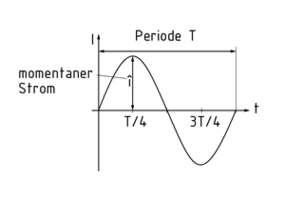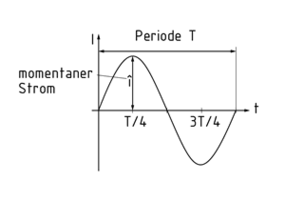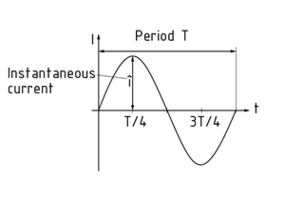
Seleccione uno
o más idiomas
0,1,3
- Alemán
- Inglés
- Chino
- Español
Corriente alterna (CA)

La corriente alterna es un flujo de carga eléctrica que cambia periódicamente de dirección de positivo a negativo. La corriente alterna requiere de un suministro de energía CA, como un generador.
Los parámetros de la CA incluyen la amplitud y la frecuencia f. Mientras que la amplitud máxima es la misma en magnitud tanto en la dirección positiva como negativa, las mitades de onda positiva y negativa se distribuyen de manera pareja con el tiempo en todas partes. La media aritmética es por lo tanto cero. La frecuencia de la corriente CA se calcula a partir del valor recíproco del tiempo que la corriente necesita para pasar a través de ambas partes, positiva y negativa, conocido como periodo T y se expresa como $f = 1/T$.
La corriente alterna toma con mayor frecuencia la forma de corriente alterna sinusoidal, la cual también se usa en aplicaciones de ingeniería eléctrica para salidas más grandes como en un sistema polifase, en la forma de corriente trifásica.
Al igual que la corriente directa, la corriente alterna cuenta con cuatro efectos importantes:
Efecto de calor: un conductor cargado eléctricamente siempre se calentará.
Efecto de luz: la corriente eléctrica hace que ciertos gases (neón, argón, vapor de mercurio) se iluminen.
Efecto magnético: la corriente eléctrica siempre genera un campo magnético.
Efecto químico: la corriente eléctrica descompone los líquidos conductivos.
Corriente alterna
Wechselstrom

Als Wechselstrom bezeichnet man einen Stromfluss, der seine Richtung periodisch vom positiven in den negativen Bereich ändert. Voraussetzung für den Wechselstrom ist eine Wechselspannungsquelle wie zum Beispiel ein Generator.
Bestimmungsgrößen für den Wechselstrom sind die Amplitudenhöhe und die Frequenz f. Während die maximale Amplitudenhöhe im Betrag in positiver und negativer Richtung gleich groß ist, teilen sich die positive und die negative Halbwelle zeitlich gleichmäßig über den gesamten Verlauf auf. Das arithmetische Mittel ist dementsprechend Null. Aus dem Kehrwert der Zeit, die der Strom für das komplette Durchlaufen des positiven und negativen Anteils benötigt, der Periode T, errechnet sich die Frequenz des Wechselstromes $f = 1/T$.
Die gebräuchlichste Form des Wechselstroms ist der sinusförmige Wechselstrom, der in der Energietechnik für große Leistungen auch als mehrphasiges System, dem Drehstrom, zum Einsatz kommt.
Wechselstrom hat genauso wie Gleichstrom vier wichtige Wirkungen:
- Wärmewirkung - ein stromdurchflossener Leiter erwärmt sich immer.
- Lichtwirkung - bestimmte Gase (Neon, Argon, Quecksilberdampf) werden von elektrischem Strom zum Leuchten angeregt.
- Magnetische Wirkung - elektrischer Strom erzeugt immer ein Magnetfeld.
- Chemische Wirkung - elektrischer Strom zerlegt leitende Flüssigkeiten.
Alternating current (AC)

Alternating current is a flow of electric charge that periodically changes direction from positive to negative. Alternating current requires an AC Power supply, such as a generator.
AC parameters include amplitude and frequency f. While the maximum amplitude is the same in magnitude in both the positive and negative direction, the positive and negative half-waves are distributed evenly over time throughout. The arithmetic mean is therefore zero. The frequency of the AC current is calculated from the reciprocal value of the time that the current needs to run through both the positive and negative parts, known as period T, and is expressed as $f = 1/T$.
Alternating current most often takes the form of sinusoidal alternating current, which is also used in electrical engineering applications for large outputs as a polyphase system, in the form of Three-phase current.
Like Direct current, alternating current has four important effects:
交流电(AC

交流电是周期性改变方向(从正到负)的一股电流。交流电需要一个交流电源,如发电机。
交流电的参数包括幅值和频率f。正向和负向的最大幅值大小相同,正向半波和负向半波随时间均匀分布。因此算术平均值为零。交流电的周期T等于电流通过一个正向和一个负向所用时间, 而频率是其周期的倒数,表达式为 $f = 1/T$。
交流电最多的形式就是正弦交流电,也以三相电流的形式在电气工程中作为多相系统输出大功率。
类似直流电,交流电有四个重要的效应影响:
热效应 - 带电导体始终放热。
光效应 - 电流点亮某些气体(氖、氩、汞蒸气)。
磁效应 - 电流总是产生磁场。
化学效应 - 电流分解导电液体。
交流电
近义词
交流电
